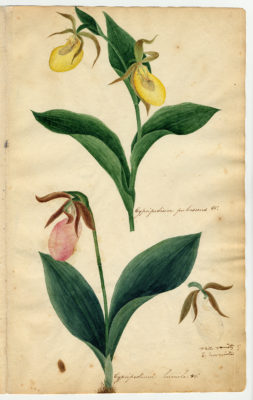CHARTING THE DIVINE PLAN: THE ART OF ORRA WHTE HITCHCOCK
Exhibition of rarely seen 19th-century female artist/scientist’s work
at American Folk Art Museum begins June 12
Charting the Divine Plan: The Art of Orra White Hitchcock (1796–1863) explores the confluence of art, love, science, and religion in the work of one of America’s first female scientific illustrators. The exhibition willbe on view at the American Folk Art Museum (2 Lincoln Sq., Columbus Ave. at 66thStreet, folkartmuseum.org) from June 12 through October 14, 2018. Hitchcock belongs to a select group of women in Europe and the United States who were uniquely privileged to nourish their own intellectual and artistic inclinations as collaborators with their scientist husbands, even as they performed their expected duties as wives and mothers. On view will be almost 100 watercolors, pen and ink drawings, prints, and classroom charts that Hitchcock created between 1810 and the 1840s, primarily for the study of botany, geology, zoology, and ichnology. The works illustrateHitchcock’s deep knowledge of the natural sciences, her telling eye for detail, her ability to visually communicate abstract and complex ideas, and her exceptional talent as an artist.
Charting the Divine Plantraces Hitchcock’s development from her schoolgirl projects to her career as a teacher, and her work as an artist in partnership with her husband, Edward Hitchcock, minister and professor of natural sciences at Amherst College. The exhibition will include rich archival materials relating to both Hitchcocks, including diaries, classroom lecture notes, and correspondence from some of the leading scientists of the 19thcentury. Charting the DivinePlanis curated by Stacy C. Hollander, acting executive director as well as deputy director for curatorial affairs and chief curator of the American Folk Art Museum.
“In the early years of the nineteenth century, when the natural world was a place of wonder, Edward Hitchcock—theologian and scientist—saw the interconnectedness of God’s created world, and Orra White Hitchcock made it manifest through her art, for all to comprehend and marvel,”says Hollander.
Born in South Amherst, Massachusetts, Orra White exhibited a prodigious scientific mind and abundant artistic talent at an early age. At 17 she was teaching drawing, painting, math and “the exact sciences” at Deerfield Academy. During this time, she became acquainted with young Edward Hitchcock, principal of the Academy, with whom she shared many scientific interests. Beginning in 1817 they began collecting and studying the native flowers and grasses in the vicinity of Deerfield, Amherst, and Conway, Massachusetts. Each specimen was then painted as a living, growing plants in precise and exquisite detail in the pages of an album Orra titled Herbarium parvum, pictum.
Edward and Orra were married in 1821. That summer they embarked on a similar project to document all the mushrooms in the vicinity of Conway, where Edward was now the Congregational pastor. The small album Orra titled Fungi selecti picti. holds significantly fewer pages than the Herbariumbut features almost as many specimens rendered in tight clusters with the same sensitive hand and eye for significant identifying details. The Hitchcocks’ activities brought them in contact with the leading botanists of the day, some of whom employed Orra’s talents to illustrate their own published work. Edward also began his own prolific publishing career with articles in The American Journal of Science, and many articles and books to follow on a wide range of scientific topics, the majority featuring illustrations by Orra Hitchcock.
After a stint as a pastor in Conway, Edward Hitchcock was named professor of chemistry and natural science at the fledgling Amherst College. He and his growing family returned to the Amherst area where Orra was responsible for running the farm and household which grew to six children, boarders, and visiting professors, as well as running weekly religious receptions, working with women’s groups and fundraisers, keeping her hypochondriacal and depressive husband functioning, and incidentally producing hundreds of artworks that now included large-scale watercolor and ink wash drawings on cotton that he used in his lectures. Showing geological cross-sections, fossilized animals, and the exciting new discovery of dinosaur footprints in the Connecticut River Valley, these works could range from two feet to up to ten feet in width.
Highlights of the exhibition include:

Classroom chart on linen drawn by Orra White Hitchcock, Amherst College. 
, meaning stony bird tracks, a field innovated by Edward Hitchcock and that we know today were made by dinosaurs
- Cover and fifteen drawings from Herbarium parvum, pictum, Hitchcock’s album of botanical watercolors
- Sectional views of the earth’s crust and geological phenomena above and below ground including Iceland’s Great Geyser and lava in Mt. Etna
- Pen, ink, and watercolor wash drawings of Mastadon Maximus, Plesiosaurus, Ichthyosaurus,Paleotherum, Edephas Primogenius, and other prehistoric vertebrates
- Perez, Mabel, and Rebekah White Mourning Piece– the earliest example of Orra’s work, it memorializes the deaths of three of her siblings and it was painted when she was 14.
Orra White Hitchcock was extolled as “an oracle of wisdom” by her students and fellow members of the Ladies Literary Society at Deerfield Academy. She was both a brilliant thinker and clinical observer of the natural world. She received recognition for the many plates illustrating her husband’s surveys of Massachusetts and that stand as some of the earliest views that capture the sublime beauty of the natural formations of the Connecticut River Valley. But it is the less well known classroom charts that today startle modern eyes with their transparent washes of gorgeous color, abstraction, clarity, and freshness.
About the American Folk ArtMuseum
The American Folk Art Museum is the premier institution devoted to the aesthetic appreciation of traditional folk art and creative expressions of contemporary self-taught artists from the United States and abroad. The museum preserves, conserves, and interprets a comprehensive collection of the highest quality, with objects dating from the eighteenth century to thepresent. For more information, please visit www.folkartmuseum.org